
The common cockchafer, also colloquially known as the Maybug, Maybeetle, or doodlebug, is a species of scarab beetle belonging to the genus Melolontha. It is native to Europe, and it is one of several closely-related and morphologically similar species of Melolontha called cockchafers, alongside Melolontha hippocastani.
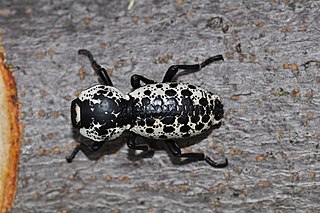
Zopheridae is a family of beetles belonging to Tenebrionoidea. It has grown considerably in recent years as the members of two other families have been included within its circumscription; these former families are the Monommatidae and the Colydiidae, which are now both included in the Zopheridae as subfamilies or even as tribe of subfamily Zopherinae. Some authors accept up to six subfamilies here, while others merge all except the Colydiinae into the Zopherinae.
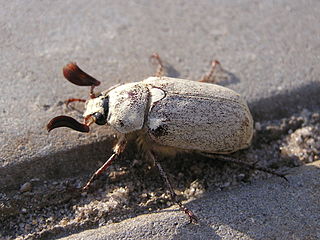
Melolonthinae is a subfamily of the scarab beetles. It is a very diverse group; distributed over most of the world, it contains over 11,000 species in over 750 genera. Some authors include the scarab subfamilies Euchirinae and Pachypodinae as tribes in the Melolonthinae.
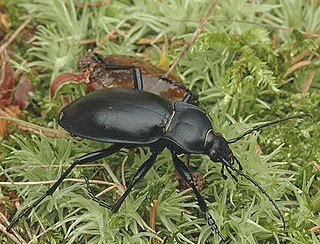
Carabus is a genus of beetles in family Carabidae. The genus is highly diverse with 94 subgenera, 959 species and 2300 subspecies, thus is the largest genus in the subfamily Carabinae. The vast majority are native to the Palearctic, but 16 Nearctic species are also known. Carabus spp. are 12–50 mm (0.47–1.97 in) long, and most species are wingless and often very colourful. These are nocturnal, predatory beetles that feed on snails, earthworms, and caterpillars. Most Carabus species were thought to have inhabited the Eurasian forest, but the species' low dispersal abilities altered the distribution of lineages within the genus.
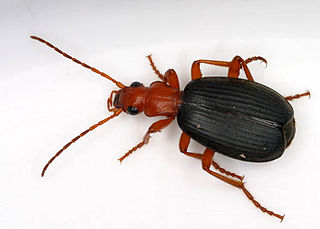
Brachinus is a genus of ground beetle native to the Nearctic, Palearctic, the Near East and North Africa. Beetles in this genus are commonly referred to as bombardier beetles. The genus contains the following species:
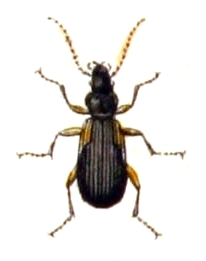
Cymindis is a genus of ground beetle native to the Palearctic, the Near East, and North Africa. It contains the following species:

Polyphylla is a genus of scarab beetle includes more than 80 species distributed in North and Central America, southern and central Europe, northern Africa, and southern Asia—from Asia Minor to Japan. They typically reside in forests and orchards with most being identified by white elytra scales forming stripes. The adult beetles are often attracted to lights. Polyphylla lay their eggs on soil near plants from where the larvae hatch and burrow down to the roots on which they will feed. They reach maturity in two to three years.

Attagenus is a genus of beetles. This genus is found in tropical Africa, the Palearctic including Europe, the Near East, the Nearctic, North Africa and East Asia. There are nearly 200 species. The genus has existed for at least 99 million years, with fossils known from the Cenomanian aged Burmese amber and Turonian aged New Jersey amber.

Agapanthia is a genus of flat-faced longhorn beetle belonging to the family Cerambycidae, subfamily Lamiinae.
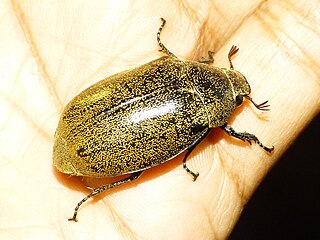
Leucopholis is a large genus of scarab beetles in the tribe Melolonthini.

Miridiba is a genus of beetles in the family Scarabaeidae, which are known for their white larvae that feed on the roots of plants. The antennae end in a short club. The mandible has a wrinkled molar lobe and the incisor lobe is depressed above. The labrum is depressed in the middle. Species within this genus are found in the Old World, mainly in eastern and tropical Asia. Many species in the genus were earlier placed in the genus Holotrichia.

Ceraspis is a genus of beetles in the subfamily Melolonthinae.
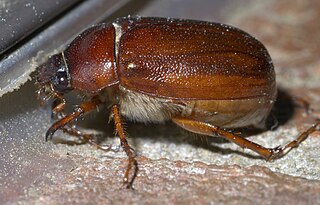
Melolonthini is a tribe of scarab beetles in the family Scarabaeidae. There are over 250 genera in Melolonthini, occurring worldwide; there are over 300 species in North America alone, and more than 3000 worldwide.

Omophlus is a genus of comb-clawed beetles belonging to the family Tenebrionidae subfamily Alleculinae.
Brahmina is a large Palearctic genus of scarab beetles in the tribe Melolonthini, containing over 90 species in three subgenera.
Cockchafer is a common name for several species of plant eating scarab beetles regarded as agricultural pests. It is most commonly used for several European species of the genus Melolontha:














